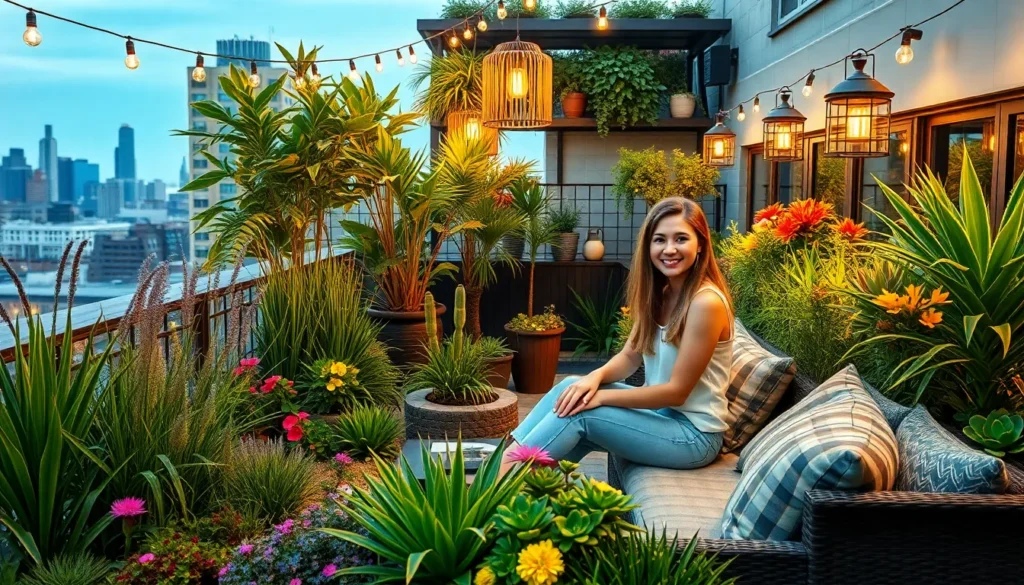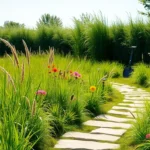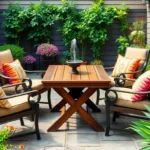Transform your empty rooftop into a thriving green paradise that’ll make your neighbors green with envy. We’ve discovered that roof gardens aren’t just trendy – they’re revolutionary spaces that boost property values while creating your own personal oasis above the city chaos.
The best part? You don’t need a massive budget or professional landscaping experience to create something spectacular. We’ve compiled game-changing ideas that work for tiny terraces and sprawling rooftops alike. From vertical herb walls that’ll revolutionize your cooking to stunning succulent displays that practically care for themselves – these aren’t your grandmother’s garden ideas.
Ready to unlock your rooftop’s hidden potential? We’ll show you exactly how to maximize every square foot while working with your space’s unique challenges. Whether you’re dreaming of a peaceful retreat or an entertainment hub that’ll wow your guests, we’ve got the creative answers that’ll transform your vision into reality.
Choose the Right Plants for Your Rooftop Environment
Selecting appropriate vegetation forms the foundation of any successful rooftop garden project. We’ll explore plant varieties that thrive in challenging rooftop conditions and provide lasting beauty for your elevated garden space.
Consider Wind-Resistant Varieties
Wind exposure creates one of the most important challenges for rooftop gardening success. We recommend selecting plants with sturdy stems and flexible branches that bend rather than break under pressure.
Ornamental grasses like fountain grass and blue fescue perform exceptionally well in windy conditions. These varieties develop deep root systems that anchor them securely while their slender blades move gracefully with air currents.
Shrubs such as boxwood, juniper, and barberry offer excellent wind resistance due to their dense growth patterns. Small trees like crabapple and serviceberry can withstand moderate wind speeds when properly staked during establishment.
Perennial flowers including black eyed Susan, purple coneflower, and sedum varieties maintain their structure even during gusty weather. These hardy plants bounce back quickly from wind damage and continue blooming throughout the growing season.
Select Drought-Tolerant Species
Rooftop environments experience faster soil drying due to increased sun exposure and wind circulation. We suggest choosing plants that store water efficiently or require minimal irrigation once established.
Succulents like hens and chicks, stonecrop, and ice plant thrive in these conditions by storing moisture in their fleshy leaves. Mediterranean herbs including lavender, rosemary, and thyme not only tolerate dry conditions but also provide culinary benefits.
Native wildflowers such as blanket flower, yarrow, and butterfly weed adapt naturally to local rainfall patterns. Drought tolerant vegetables like cherry tomatoes, peppers, and Swiss chard allow you to grow food while conserving water.
Ornamental options including Russian sage, catmint, and salvia produce stunning blooms with minimal water requirements. These plants actually perform better in slightly dry conditions than in consistently moist soil.
Opt for Shallow Root Plants
Weight restrictions on rooftops limit soil depth, making shallow rooted plants essential for structural safety. We focus on species that develop extensive horizontal root systems rather than deep taproots.
Annuals such as marigolds, petunias, and impatiens establish quickly in containers with 6 to 8 inches of growing medium. Lettuce, spinach, and radishes grow successfully in shallow planters while providing fresh produce for your kitchen.
Ground covers like creeping phlox, ajuga, and moss phlox spread horizontally across surfaces without requiring deep soil penetration. These plants create living carpets that suppress weeds and reduce maintenance needs.
Dwarf varieties of traditional plants offer the same visual appeal with reduced root depth requirements. Compact hostas, miniature daylilies, and dwarf conifers provide structure and color while respecting weight limitations on your rooftop space.
Create Functional Seating and Relaxation Areas
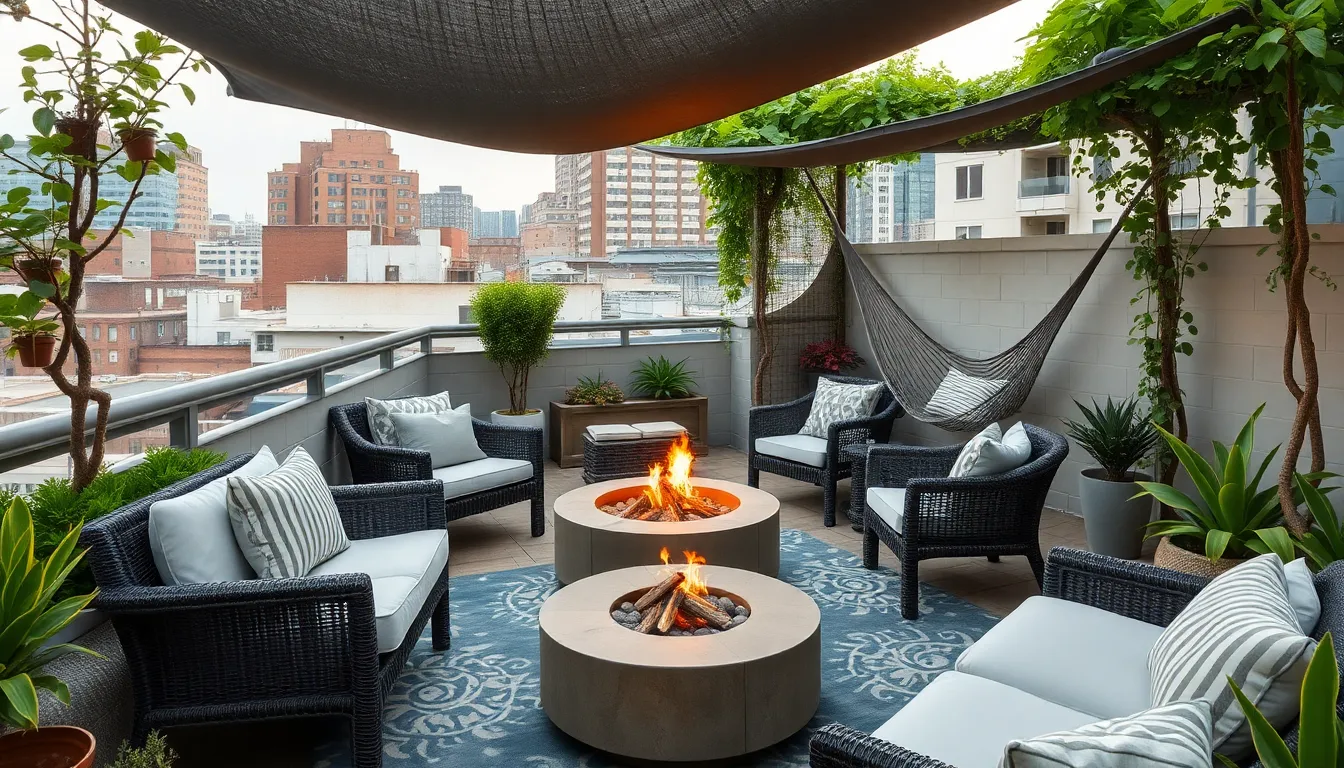
Transforming your rooftop into a comfortable retreat requires thoughtful furniture placement and cozy elements that encourage extended outdoor living. We’ll help you design inviting spaces that withstand weather conditions while maximizing comfort and functionality.
Install Weather-Resistant Outdoor Furniture
Durable materials form the foundation of successful rooftop seating areas. Recycled plastic, metal, and treated wood furniture options resist harsh weather conditions while maintaining their appearance season after season. These materials handle temperature fluctuations, rain exposure, and UV radiation without cracking or fading significantly.
Easy maintenance features save time and extend furniture lifespan. We recommend selecting pieces with removable cushions and covers that allow for simple cleaning and winter storage. Furniture with powder coated finishes and stainless steel hardware prevents rust formation in humid rooftop environments.
Fire pits and outdoor heaters extend your rooftop’s usable seasons. Adding these warming elements creates comfortable gathering spots during cooler evenings and extends your outdoor entertainment calendar. Weather resistant benches, chairs, and sofas positioned around heat sources create natural conversation areas.
Add Comfortable Cushions and Textiles
Waterproof cushions protect your investment from unexpected weather changes. Selecting cushions with waterproof covers prevents moisture damage while maintaining comfort during extended outdoor use. These specialized covers resist mold and mildew formation that typically affects traditional indoor textiles.
Outdoor rugs define seating areas and add warmth underfoot. Strategic rug placement creates visual boundaries between different functional zones while providing comfort on hard rooftop surfaces. Weather resistant rugs made from polypropylene or solution dyed acrylic withstand moisture and UV exposure.
Removable textile elements offer seasonal flexibility. Cushion covers, throw pillows, and lightweight blankets allow you to refresh your space’s appearance throughout the year. Storage containers placed nearby keep these items protected during harsh weather periods.
Design Cozy Reading Nooks
Shaded areas provide essential protection from intense sun exposure. Umbrellas, canopies, and pergolas create comfortable spots for extended reading sessions while reducing glare on book pages. These structures also offer partial weather protection during light rain showers.
Comfortable seating options enhance relaxation in dedicated reading spaces. Plush, weather resistant bean bags and hammocks provide ergonomic support for long reading sessions. These lightweight options allow easy repositioning to follow shade patterns throughout the day.
Vertical gardens enhance natural ambiance around reading areas. Green walls and climbing plants create privacy screens while improving air quality in your rooftop retreat. Ivy and arborvitaes add lushness to reading nooks while requiring minimal maintenance once established.
Incorporate Vertical Growing Solutions
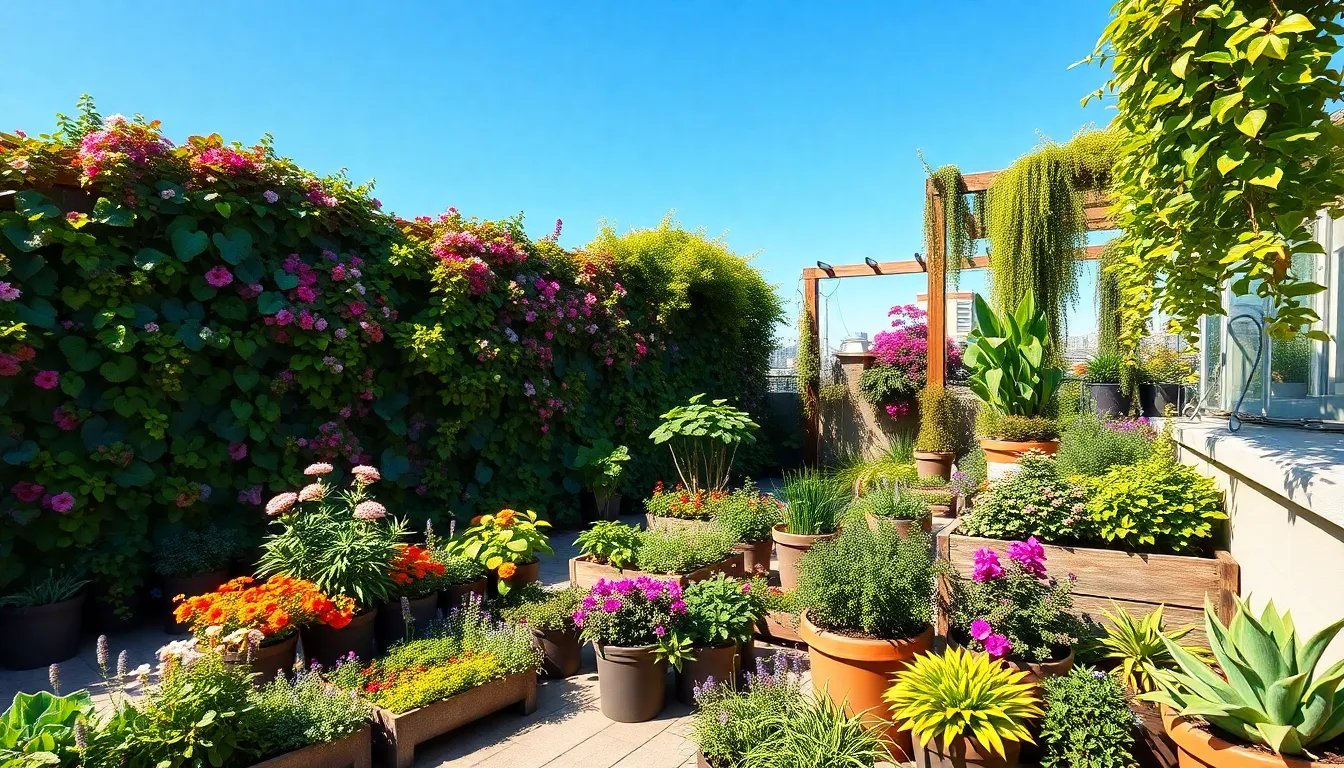
Maximizing our rooftop space becomes effortless when we embrace vertical growing techniques that transform bare walls into thriving green ecosystems.
Install Living Walls and Green Screens
Living walls provide exceptional insulation benefits while creating stunning plant-covered surfaces that enhance any roof design. We can integrate these vertical garden systems directly into our existing rooftop structures, transforming plain walls into lush green backdrops that support perennials and climbing varieties.
Green screens offer dual functionality by creating natural privacy barriers while blocking unsightly urban views. These installations allow us to strategically position climbing plants and trailing species that grow upward, effectively maximizing our growing space without consuming valuable floor area.
Installing these systems requires minimal structural modifications since most living wall frameworks distribute weight evenly across wall surfaces. We’ll find that these vertical answers significantly reduce our heating and cooling costs by providing natural insulation throughout the year.
Use Trellises for Climbing Plants
Climbing plants thrive on trellises, giving us opportunities to grow ivy, clematis, and wisteria that add dramatic height and visual interest to our rooftop gardens. These support structures enable us to cultivate vigorous climbers that would otherwise sprawl across valuable floor space.
Trellis installation works exceptionally well against existing walls or as freestanding features that create natural room dividers within our rooftop space. We can position these structures to support heavy flowering vines that produce seasonal blooms, adding color and fragrance throughout the growing season.
Selecting the right climbing varieties ensures our trellises remain productive year after year. We should choose plants that match our climate conditions and maintenance preferences, focusing on species that won’t overwhelm the support structure as they mature.
Create Tiered Planting Systems
Tiered gardens use multiple elevation levels through terraces and containers, allowing us to cultivate diverse plant communities within limited rooftop areas. These multi-level systems create visual depth while providing distinct growing environments for different plant types.
Drainage and support systems become critical components when we design tiered installations, preventing water accumulation that could compromise structural integrity. We must ensure each tier receives adequate drainage while maintaining stability across all elevation levels.
Container arrangements within tiered systems enable us to grow plants with varying water and soil requirements in the same general area. We can position drought-tolerant succulents on upper tiers while placing moisture-loving herbs and vegetables on lower levels where irrigation naturally collects.
Strategic plant placement across different tiers maximizes our growing capacity while creating stunning visual displays that change throughout the seasons. We’ll discover that these multi-level approaches transform even modest rooftop areas into impressive garden showcases.
Design Effective Water Management Systems
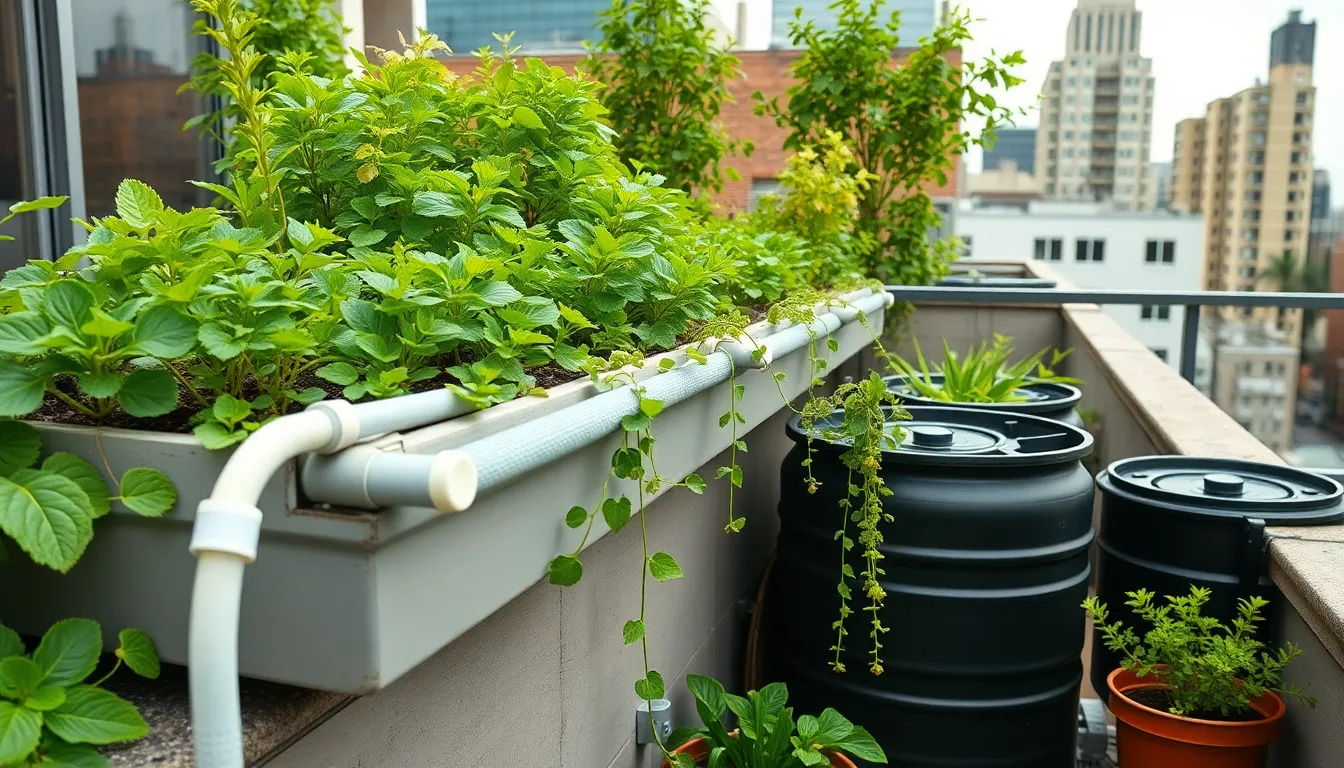
Water management forms the backbone of any successful roof garden, ensuring plants thrive while protecting your building’s structural integrity. Smart irrigation and drainage systems maximize water efficiency while minimizing maintenance demands.
Set Up Drip Irrigation Networks
Drip irrigation delivers water directly to plant roots with precision and efficiency that traditional sprinkler systems can’t match. We recommend installing perforated tubes along your planted areas, positioning them close to root zones for maximum absorption. Emitters control water flow to individual plants, allowing you to customize watering based on each species’ exact needs. Controllers program automatic watering schedules that adapt to weather conditions and soil moisture levels, reducing water waste by up to 50% compared to conventional irrigation methods.
Install Water Collection and Storage
Rainwater harvesting transforms your rooftop into an eco-friendly water source that reduces municipal water dependency. Rain barrels offer simple individual storage answers, while modular systems allow you to expand capacity as your garden grows. Cisterns provide larger storage tanks for surplus rainwater collection, ideal for extensive roof gardens with diverse plant communities. Gutters and downspouts channel precipitation directly into your storage system, capturing every drop of nature’s free irrigation.
Plan Proper Drainage Answers
Proper drainage prevents water accumulation that can damage your roof structure and harm plant health. Overflow management systems redirect excess water away from your building’s foundation, protecting both your garden and property investment. Drainage channels create strategic pathways for water flow, guiding runoff into collection systems or designated drainage areas. Installing these systems early in your planning process ensures your roof garden remains healthy during heavy rainfall while maintaining structural safety standards.
Add Windbreaks and Privacy Screens
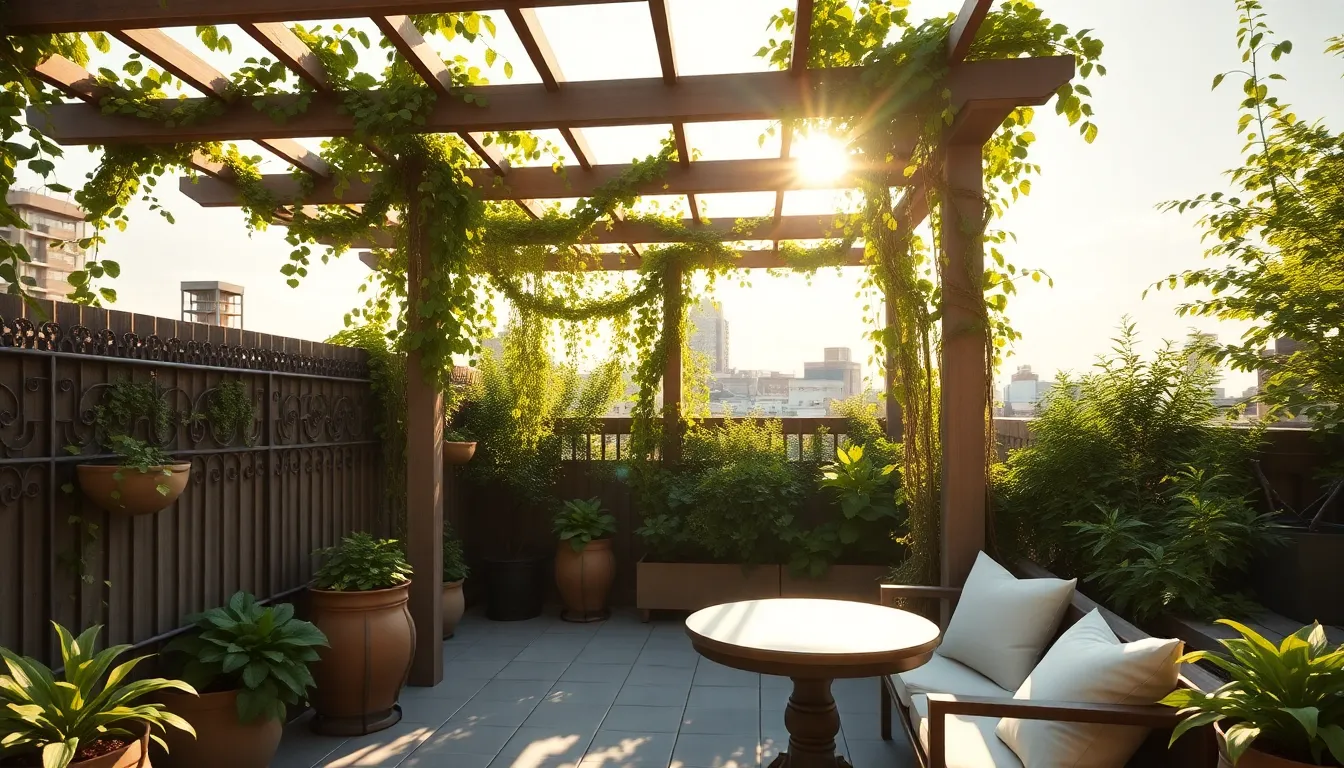
Creating effective barriers transforms exposed rooftops into intimate retreats while protecting our garden spaces from harsh winds.
Build Pergolas and Overhead Structures
Pergolas provide essential shade and structural support for climbing plants like vines or wisteria. We can create comfortable gathering spaces by installing these overhead frameworks that define outdoor rooms while reducing wind exposure. Gazebos offer complete protection from both sun and rain, extending our rooftop’s usability throughout different weather conditions.
Canopies create flexible shelter options that we can adjust based on seasonal needs. These overhead structures serve dual purposes by supporting plant growth and creating defined spaces for dining or relaxation. We’ll find that pergolas particularly excel at breaking up strong wind patterns while maintaining open sightlines.
Plant Strategic Hedging and Barriers
Arborvitaes create natural screens that block neighbors’ views while adding lushness to urban landscapes. We can plant these evergreen trees in rows to establish year round privacy boundaries. Layered planters using different heights generate visual depth while acting as effective wind barriers.
Ivy and climbing hydrangeas transform bare walls into verdant backdrops that provide both privacy and aesthetic appeal. These climbing plants establish natural barriers over time, requiring minimal maintenance once established. We should consider green walls or living walls as vertical answers that maximize our barrier potential without consuming floor space.
Vertical gardens serve as natural windbreaks while incorporating productive growing space into our privacy answers. These installations can house herbs, vegetables, or ornamental plants depending on our preferences.
Install Decorative Fencing Options
Railings integrated with planters combine structural requirements with greenery to create natural barriers. We can incorporate built in growing spaces that soften hard edges while maintaining safety standards. These combinations provide immediate privacy while our planted elements mature.
Decorative elements like statues enhance visual interest when combined with functional fencing answers. We’ll discover that mixing decorative and practical elements creates focal points while serving barrier purposes. These installations can incorporate lighting, water features, or artistic elements that reflect our personal style preferences.
Include Lighting for Evening Ambiance
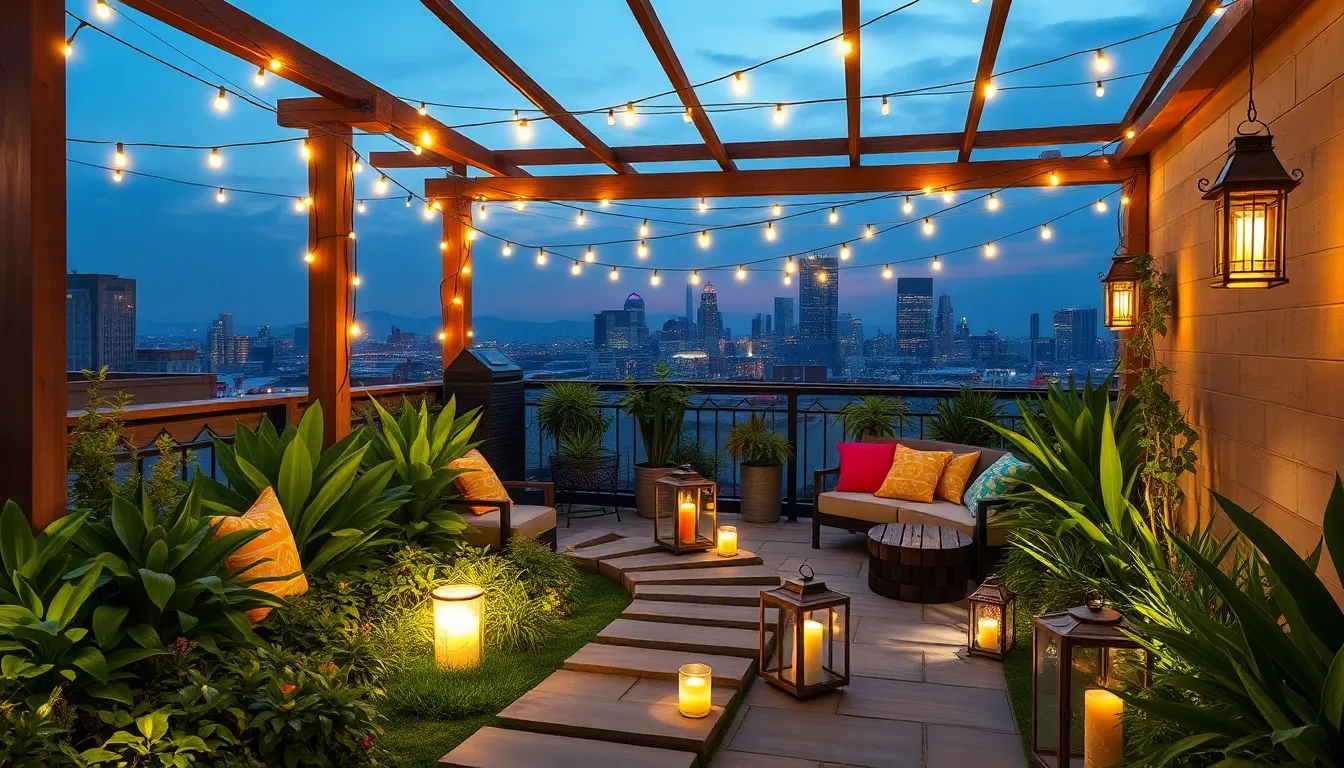
Transforming your rooftop garden into a magical evening retreat requires thoughtful illumination that extends outdoor enjoyment well past sunset. Strategic lighting placement creates warm ambiance while highlighting your garden’s best features.
String Solar-Powered LED Lights
String solar-powered LED lights offer an energy-efficient solution that adds instant warmth to any rooftop space. These versatile fixtures eliminate the need for electrical wiring while providing consistent illumination throughout the evening hours. We recommend draping them along pergola beams, wrapping them around railings, or creating dramatic swags across open areas.
Solar technology ensures these lights automatically charge during daylight hours and illuminate your garden without increasing electricity costs. Installation takes minutes rather than hours, making them perfect for renters or anyone seeking quick ambiance improvements. Weather-resistant designs withstand rooftop conditions including wind, rain, and temperature fluctuations.
Install Pathway and Accent Lighting
Pathway lighting creates safe navigation routes while showcasing your rooftop garden’s key features after dark. Solar-powered pathway lights work exceptionally well in rooftop environments where direct sunlight provides ample charging opportunities throughout the day. Position these fixtures along walkways, around seating areas, and near garden borders to define spaces clearly.
Accent lighting highlights exact plants, water features, or architectural elements that deserve evening attention. Spotlights directed upward create dramatic shadows and depth, while ground-level fixtures provide subtle illumination without overwhelming delicate plantings. We suggest focusing accent lights on vertical gardens, specimen plants, or decorative elements that showcase your rooftop’s unique character.
Add Lanterns and Candle Features
Lanterns bring portable ambiance that adapts to changing entertainment needs and seasonal preferences. Hanging lanterns from pergola structures or shepherd’s hooks creates intimate lighting zones perfect for dining or conversation areas. Battery-operated LED versions provide consistent light without fire hazards, while traditional candle lanterns offer authentic flickering warmth.
Candle features in safe holders transform ordinary evenings into special occasions with their natural glow and gentle movement. Glass hurricane lamps protect flames from rooftop breezes while creating stunning light patterns on surrounding surfaces. We recommend grouping candles at varying heights to establish cozy focal points that encourage relaxation and social gathering.
Create Dedicated Growing Zones
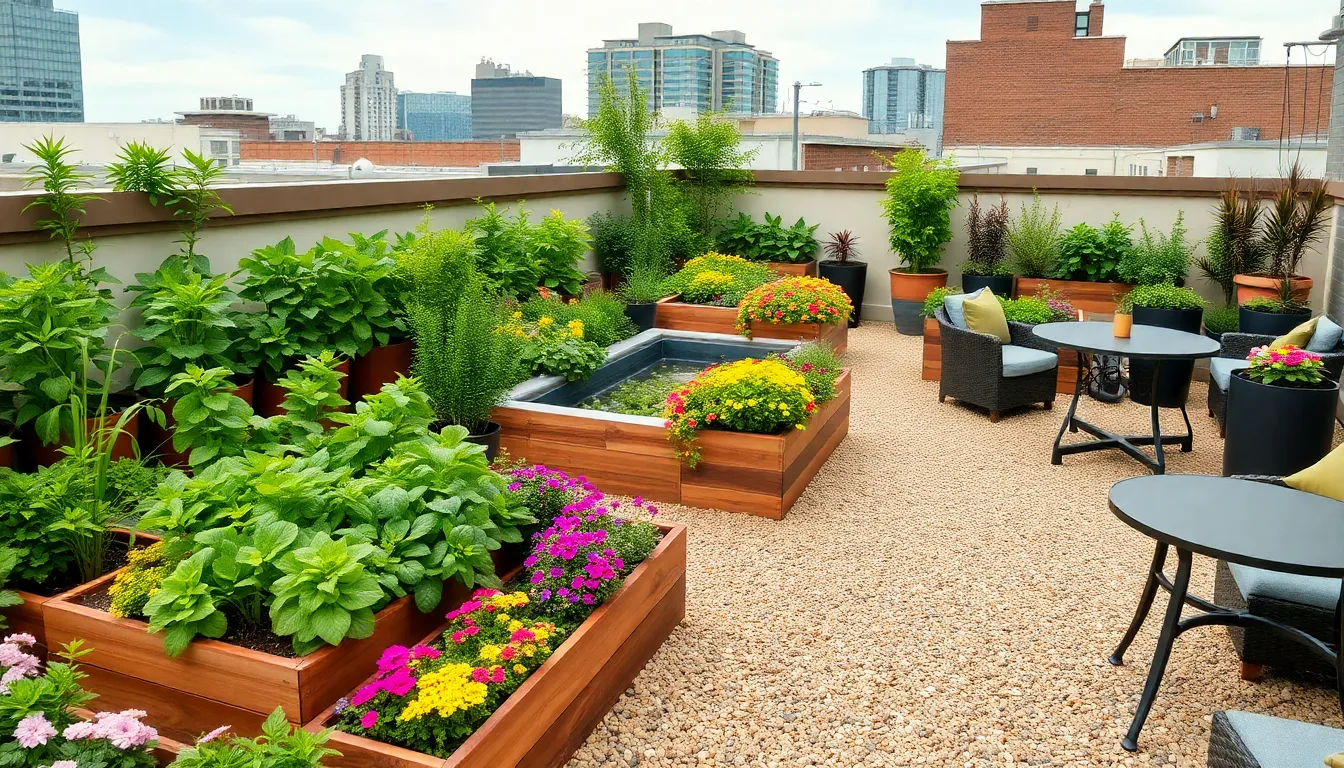
Strategic organization transforms chaotic rooftop spaces into productive growing areas that maximize plant health and gardening efficiency. We’ll explore how dividing your roof garden into specialized zones creates better growing conditions and simplifies maintenance routines.
Establish Herb and Vegetable Gardens
Designate separate areas for herbs and vegetables to optimize plant growth and ensure easy access during cooking and harvesting. Raised beds offer superior soil quality control compared to ground-level planting, while proper drainage prevents root rot in container environments.
Select compact or dwarf varieties of your favorite herbs and vegetables to maximize productivity in limited rooftop spaces. Cherry tomatoes, bush beans, and miniature peppers thrive in containers while providing abundant harvests throughout the growing season.
Carry out vertical gardens using wall-mounted planters or sturdy trellises to accommodate vining plants like cucumbers, peas, and climbing beans. These space-saving answers double your growing capacity without expanding your rooftop footprint.
Group plants with similar water and sunlight requirements together to streamline care routines and prevent over or under watering sensitive varieties. Mediterranean herbs like rosemary and thyme pair well in sunny, well-drained sections, while leafy greens prefer partially shaded areas with consistent moisture.
Design Flower Beds and Color Schemes
Consider the surrounding industry when selecting flower colors to create visual harmony between your rooftop garden and the broader environment. Urban settings benefit from bright, bold colors that stand out against concrete and steel backgrounds.
Use layered planters of varying heights to add visual depth and create ever-changing flower displays that catch the eye from multiple viewing angles. Tall planters in back showcase dramatic flowers like sunflowers or delphiniums, while shorter containers in front highlight compact blooms.
Plan seasonal color transitions by selecting flowers that bloom at different times throughout the year, ensuring continuous visual interest from spring through fall. Early spring bulbs give way to summer annuals, followed by autumn-blooming perennials and ornamental grasses.
Create focal points using specimen plants or unique flower combinations that draw attention and serve as conversation starters during gatherings. Bold architectural plants like ornamental grasses or dramatic foliage plants anchor flower bed designs.
Set Up Container Gardening Areas
Incorporate small water features like birdbaths or compact fountains to enhance the garden’s ambiance while attracting beneficial birds and insects to your rooftop oasis. The sound of flowing water masks urban noise pollution and creates a tranquil atmosphere.
Add gravel pathways and comfortable seating areas to create inviting spaces where family and friends can gather to enjoy the garden environment. Weather-resistant materials ensure these features withstand rooftop conditions year after year.
Use statues or sculptures strategically placed throughout container groupings to add personality and artistic flair to your rooftop garden design. These decorative elements create visual anchors that tie different planting areas together cohesively.
Arrange containers in odd-numbered groupings of varying sizes and heights to create natural-looking displays that avoid the rigid appearance of formal gardens. This technique mimics organic plant communities found in nature.
Install Weather Protection Features
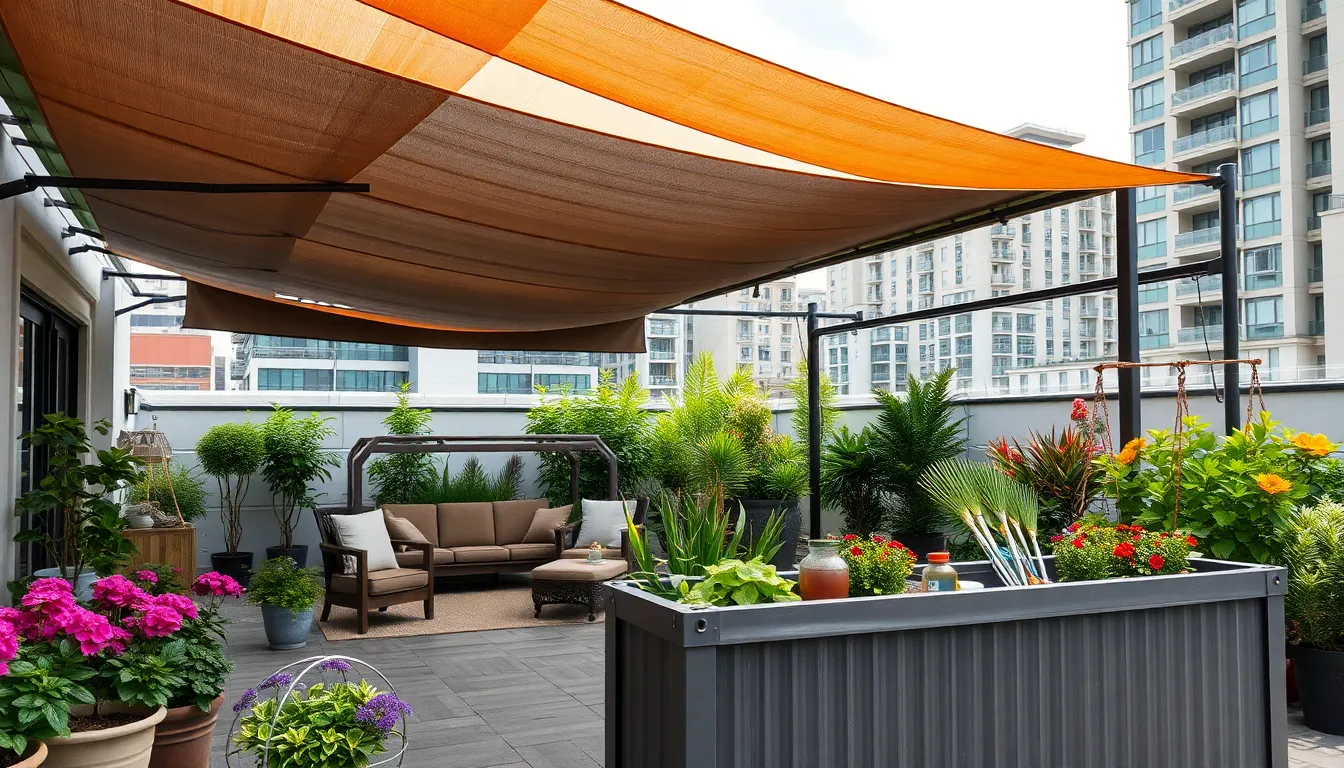
Weather protection transforms your rooftop garden from a seasonal space into a year-round retreat. Strong winds and unpredictable weather conditions pose the biggest challenges for rooftop gardening success.
Add Retractable Awnings and Shade Sails
Retractable awnings provide flexible protection that adapts to changing weather conditions throughout the day. We can adjust these structures to shield plants from intense direct sunlight while allowing beneficial morning rays to reach your garden. Modern retractable systems feature weather-resistant fabrics that withstand wind speeds up to 25 mph when properly installed.
Shade sails offer additional coverage with contemporary geometric designs that complement urban rooftop aesthetics. Installation requires sturdy anchor points, but the investment pays dividends in plant protection and outdoor comfort. Quality shade sails block up to 95% of harmful UV rays while maintaining air circulation essential for plant health.
Wind protection becomes crucial when we position these structures strategically around vulnerable plants. Trellises and other structural elements work alongside awnings to create effective windbreaks that protect delicate foliage from rooftop gusts.
Create Covered Dining Areas
Gazebos provide permanent shelter that creates intimate dining spaces within your rooftop garden. We recommend selecting weather-resistant materials like powder-coated aluminum or treated cedar that withstand constant exposure to elements. These structures serve dual purposes by supporting climbing plants while offering shade and wind protection.
Pergolas with retractable canopies give us flexibility to enjoy open-air dining or covered protection as weather demands. Installing outdoor-rated electrical connections during construction allows for integrated lighting and ceiling fans that enhance comfort during warm evenings.
Outdoor furniture selection requires weatherproof materials that resist fading and moisture damage. We suggest investing in high-quality pieces that complement your garden’s aesthetic while providing long-term durability under challenging rooftop conditions.
Build Weatherproof Storage Answers
Waterproof containers protect gardening tools and supplies from moisture damage that commonly occurs in exposed rooftop environments. We can repurpose attractive deck boxes or purchase specialized garden storage units that blend seamlessly with outdoor décor. These containers should feature tight-sealing lids and drainage systems to prevent water accumulation.
Small sheds or storage rooms offer comprehensive protection for larger equipment like hoses, fertilizers, and seasonal decorations. Building codes often regulate rooftop structures, so we need to verify permit requirements before installing permanent storage answers. Modular storage systems provide flexibility for changing needs while maintaining easy access to essential gardening supplies.
Proper waterproofing ensures structural integrity and prevents leaks that could damage both your roof and stored items. We recommend consulting roofing professionals to verify that additional storage weight falls within your roof’s load-bearing capacity before installation.
Incorporate Water Features and Focal Points

Transforming your rooftop garden with water features and focal points creates a serene atmosphere that enhances both visual appeal and property value. These elements serve as natural stress relievers while adding sophistication to your urban oasis.
Install Small Fountains or Water Gardens
Sheet waterfalls offer a modern aesthetic that complements contemporary rooftop designs while creating soothing background sounds. We recommend positioning these features against walls or structural elements to maximize their visual impact and minimize wind interference.
Rock bubblers provide subtle water movement without overwhelming smaller rooftop spaces. Installing these fountains requires less structural support than larger water features, making them ideal for weight-sensitive roofs.
Fish ponds introduce movement and life to your rooftop garden through colorful koi or goldfish swimming patterns. Depth should remain between 18-24 inches to prevent freezing while maintaining adequate fish habitat.
Reflecting pools create mirror-like surfaces that double your garden’s visual space and reflect surrounding plantings. Position these features to capture sky views and architectural elements for maximum depth enhancement.
Artificial streams using rocks and gravel mimic natural water flow without requiring complex plumbing systems. Dry streams offer similar visual interest during maintenance periods or drought conditions.
Add Sculptural Elements and Art Pieces
Statues and sculptures serve as permanent focal points that draw attention throughout changing seasons. Material selection should prioritize weather-resistant options like bronze, stainless steel, or treated stone that withstand rooftop wind exposure.
Wall-mounted art pieces maximize vertical space while creating visual interest against blank surfaces. Secure mounting becomes critical in rooftop environments where wind loads exceed ground-level installations.
Abstract sculptures complement modern architectural lines while providing conversation starters for entertaining areas. Scale these pieces appropriately to avoid overwhelming smaller rooftop gardens or underwhelming larger spaces.
Create Fire Pit or Heating Areas
Fire pits extend rooftop garden usability into cooler months while creating natural gathering spots for socializing. Gas-powered models offer convenience and safety advantages over wood-burning alternatives in urban rooftop settings.
Outdoor heaters provide targeted warmth for exact seating areas without requiring permanent installation commitments. Radiant models work effectively in windy conditions that challenge traditional flame-based heating.
Heating zones strategically positioned around seating areas allow flexible use patterns based on weather conditions and guest numbers. Combine multiple heating sources to create comfortable microclimates within larger rooftop spaces.
Professional consultation ensures structural integrity when adding water features and heavy sculptural elements to existing roof systems. Load calculations prevent costly damage while maximizing feature installation possibilities.
Recirculating pumps conserve water in fountain installations while maintaining continuous operation throughout growing seasons. Rainwater collection systems further reduce operational costs and environmental impact.
Plan for Year-Round Maintenance and Care
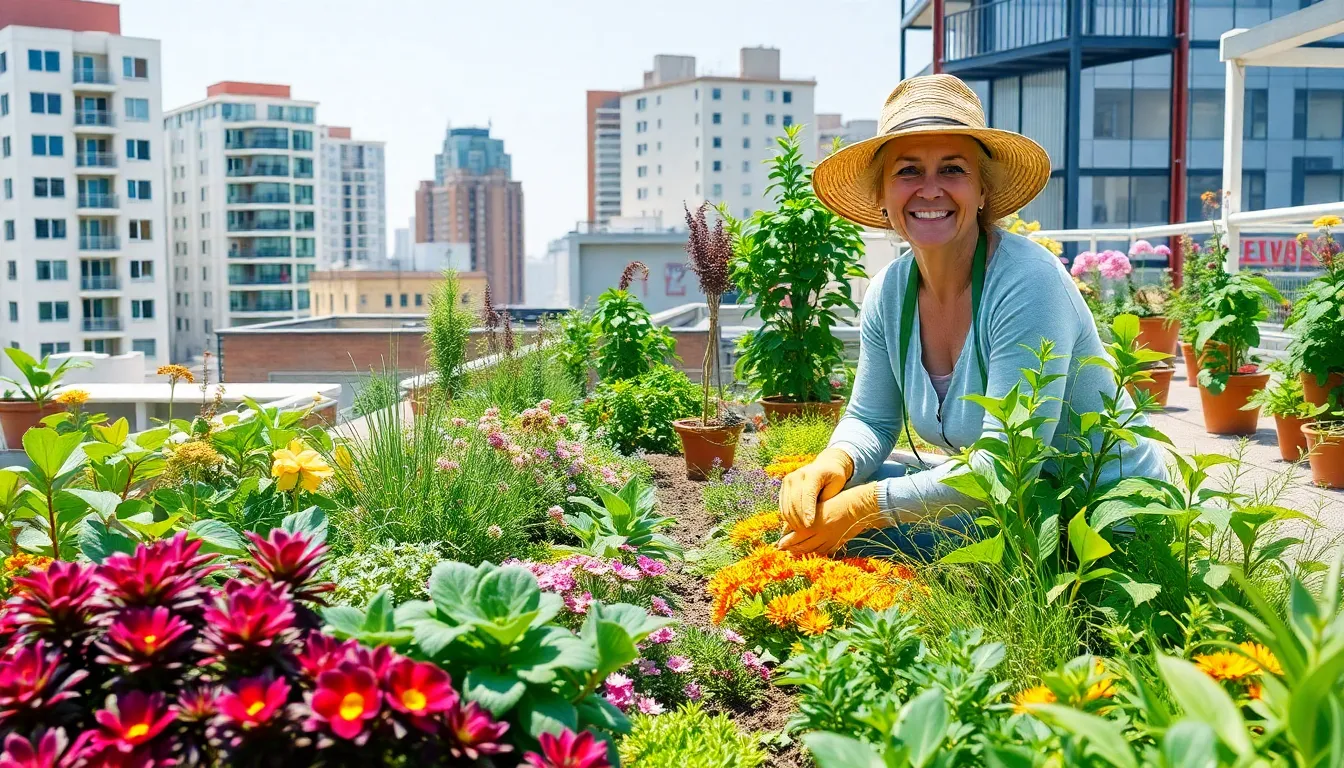
Successful roof gardens require consistent maintenance throughout all seasons to ensure healthy plant growth and structural integrity. We’ll explore essential strategies for keeping your elevated garden thriving regardless of weather conditions.
Schedule Seasonal Plant Rotation
Spring marks the perfect time to evaluate our rooftop garden’s plant performance and make necessary replacements. We should remove struggling plants that didn’t survive winter conditions and introduce fresh species better suited to our roof’s microclimate. Adding nutrients specifically formulated for our chosen plant types ensures optimal growth as temperatures rise.
Summer demands vigilant monitoring for pests and diseases that thrive in warm conditions. We need to maintain consistent watering schedules while watching for signs of heat stress in our plants. Regular inspection of drip irrigation systems helps prevent water waste and ensures even distribution.
Autumn requires preparation for the dormant season ahead. We must remove dead plant material to prevent pest harboring and disease development. Applying protective mulch around plant bases helps insulate root systems from temperature fluctuations.
Winter focuses on protecting our investment through proper plant care. We should ensure adequate insulation around sensitive species and monitor for wind damage after storms. Reducing watering frequency prevents root rot while maintaining minimal moisture levels.
Plan Winter Protection Strategies
Insulation becomes critical for protecting plants from frost damage during cold months. We can use protective covers made from breathable materials or apply organic mulch around plant bases to maintain soil temperature. Multiple layers of protection work better than single heavy coverings.
Wind protection prevents desiccation and physical damage to our rooftop plants. Installing temporary windbreaks using fabric screens or permanent structures like glass panels shields vulnerable species. Strategic placement of these barriers redirects harsh winds while maintaining air circulation.
Drainage management prevents water accumulation that leads to root rot and structural damage. We must regularly inspect and clear rainwater drains to ensure proper water flow. Installing additional drainage answers in problem areas protects both plants and building integrity.
Organize Tool and Equipment Storage
Storage areas need weatherproof protection to preserve our gardening tools and equipment. We should designate secure spaces using waterproof containers or dedicated garden sheds that withstand rooftop conditions. Organizing tools by frequency of use streamlines maintenance tasks.
Access to storage areas must remain convenient for regular maintenance activities. We can position storage answers near garden zones while ensuring they don’t obstruct foot traffic or plant growth. Easy retrieval of tools encourages consistent garden care throughout the year.
Conclusion
Your rooftop holds incredible potential to become a thriving garden retreat that we’ve explored through various creative answers. From selecting wind-resistant plants to installing proper drainage systems we’ve covered the essential elements that’ll transform your empty rooftop into a functional outdoor oasis.
Remember that successful roof gardens don’t happen overnight but with thoughtful planning and the right combination of plants furniture and protective features you’ll create a space that serves you year-round. We’ve shown you how strategic lighting water features and maintenance routines can elevate your rooftop from basic to extraordinary.
Start small with one or two ideas that excite you most then gradually expand your rooftop garden as you gain confidence and experience. Your urban sanctuary awaits!
Frequently Asked Questions
How much does it cost to create a rooftop garden?
Creating a rooftop garden doesn’t require a large budget. Costs vary depending on size and features, but you can start small with containers, basic plants, and DIY solutions. Budget-friendly options include using recycled containers, choosing drought-tolerant plants, and building simple structures yourself. Professional installation of complex features like irrigation systems or pergolas will increase costs.
What plants work best for rooftop gardens?
Wind-resistant plants like ornamental grasses and certain shrubs are ideal for rooftop conditions. Drought-tolerant species including succulents and Mediterranean herbs handle rooftop challenges well. Choose shallow-rooted plants for structural safety, such as annuals, ground covers, and dwarf varieties. These plants can withstand wind exposure and soil drying common in rooftop environments.
How do I protect my rooftop garden from wind and weather?
Install windbreaks using trellises, pergolas, or decorative fencing to shield plants from strong winds. Use retractable awnings and shade sails for weather protection while allowing beneficial sunlight. Create covered areas with gazebos or pergolas with retractable canopies. Choose weather-resistant furniture and ensure proper drainage to prevent water damage during storms.
What furniture is best for rooftop spaces?
Select weather-resistant outdoor furniture that can withstand sun, rain, and wind exposure. Look for materials like aluminum, teak, or synthetic wicker. Include comfortable cushions with waterproof covers. Consider adding fire pits or outdoor heaters to extend usability during cooler evenings. Ensure furniture is lightweight enough for rooftop structural limits.
How do I water plants in a rooftop garden effectively?
Install smart irrigation systems like drip irrigation or soaker hoses for efficient watering. Consider rainwater harvesting techniques to collect and reuse precipitation. Ensure proper drainage to prevent water accumulation that could damage the roof structure. Group plants with similar water needs together and use mulch to retain moisture in containers.
Can I grow vegetables on my rooftop?
Yes, rooftops are excellent for vegetable gardening. Create dedicated growing zones with raised beds for better soil quality. Choose compact varieties that maximize productivity in limited space. Use vertical gardening techniques for vining plants like tomatoes and beans. Herbs and vegetables actually thrive in the sunny conditions typical of most rooftops.
How do I maintain my rooftop garden year-round?
Implement seasonal plant rotation strategies and proper winter protection including insulation and wind barriers. Manage pests regularly and ensure adequate drainage during all seasons. Organize tool storage for easy maintenance access. Plan for seasonal blooms and adjust watering schedules based on weather conditions. Regular pruning and fertilizing keep plants healthy throughout the year.
What lighting options work best for rooftop gardens?
Solar-powered LED string lights provide energy-efficient illumination without requiring electrical work. Install pathway and accent lighting to enhance safety and showcase garden features after dark. Add lanterns and candles to create intimate lighting zones. Consider uplighting for trees and architectural features. Solar options are ideal since rooftops receive abundant sunlight for charging.

